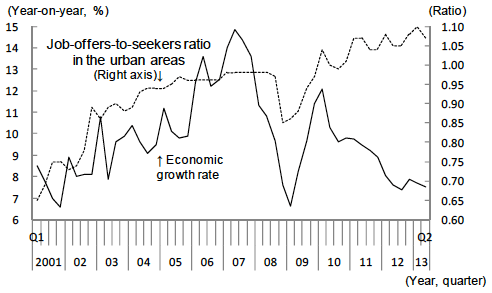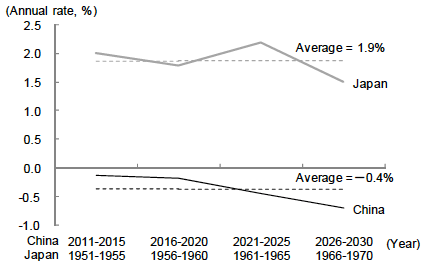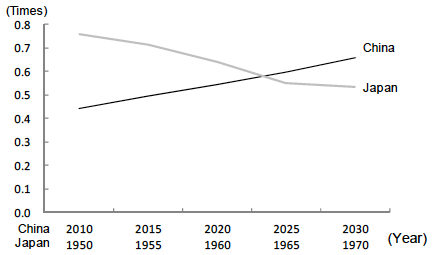China's economic growth rate (real GDP growth rate) reached an annual average of 9.8% between 1978, when it shifted its policies to reform and opening up, and 2012, but it has since declined significantly. This figure was 7.5% in the second quarter of 2013, falling below 8% for the fifth consecutive quarter since the second quarter of 2012. Professor Justin Yifu Lin of Peking University, who was also the chief economist of the World Bank until last year, argues that this decline in the growth rate is only due to cyclical factors and China can maintain 8% growth over the medium and long term, but doubts remain.
Keys to China's growth: Latecomer advantage and comparative advantage
According to Professor Lin, China has the potential to maintain an 8% economic growth rate in the future if the country capitalizes on its latecomer advantage and the government actively supports economic development in areas such as infrastructure investment according to the principle of comparative advantage (see "Justin Yifu Lin Answers Questions: Main Points of New Structural Economics" on FTchinese.com, October 25, 2012, and "The Potential for Economic Growth in China" on FTchinese.com, August 28, 2013). The grounds for his argument are as follows:
First, as there is still a large difference in technology and industry between China and the developed nations, industrial advances due to innovation will continue to sustain high economic growth. Unlike those developed nations that already have leading-edge technologies and must be self-reliant for further advances in research and development (R&D), developing countries such as China can introduce existing industries and technologies from developed nations through direct investment and other means. As this will enable China to keep its R&D costs low, it is akin to killing two birds with one stone. This is the so-called latecomer advantage.
China's relatively low gross domestic product (GDP) per capita also indicates large room for exploiting latecomer advantage. Taking into account its purchasing power parity, China's GDP per capita was only 21% of that of the United States in 2008, which is equivalent to the difference in GDP per capita between the United States and Japan, Singapore, and South Korea in 1951, 1967, and 1977, respectively. Since then, Japan, Singapore, and South Korea maintained a high annual economic growth rate of 9.2%, 8.6%, and 7.6%, respectively, for 20 years. If this experience can be applied to China, it can expect a potential annual growth rate of 8% for up to 20 years starting from 2008.
In addition, as indicated by the experience of many countries, with other things being equal, countries that have adopted development strategies in line with their comparative advantage, which reflect their factor endowment, tend to grow faster. A country's factor endowment and, in turn, its comparative advantage change over time as its economy develops. In order to ensure that these changes are accurately reflected in the country's industrial structure in the process of industrial upgrading, the government needs to support companies by selecting growth areas based on its industrial policy and implementing public investment in areas such as infrastructure.
Particularly in China, there is plenty of room for infrastructure improvement. While public investment so far has been concentrated in the construction of ports, airports, and high-speed railways, the focus is shifting to the construction of subways in urban areas and environmental conservation, such as sewage treatment facilities. Expanding public investment in these areas should have significant repercussions on the economy and society. The Chinese government is well prepared for this job, given its sound fiscal condition.
Overlooked demographic factors that could constrain growth
While correctly emphasizing the exploitation of latecomer advantage and comparative advantage as key factors determining long-term economic growth, Professor Lin has not paid due consideration to the demographic factors that could constrain growth. As a result, he may have overestimated the current and future potential growth rates of the Chinese economy.
Although Professor Lin argues that the current decline in China's economic growth rate is only due to cyclical factors and does not reflect a decline in the potential growth rate, I am forced to question his argument, given the fact that a labor shortage has persisted despite a sharp slowdown in economic growth (Figure 1). More specifically, until 2010, there was a correlation between the job offers-to-seekers ratio (the number of job offers / the number of job seekers) and the economic growth rate, in which the former rose in conjunction with the latter. Since then, however, when the economic growth rate has declined, the job offers-to-seekers ratio has risen instead. While the economic growth rate remained at 7.5% in the second quarter of 2013, the job offers-to-seekers ratio reached a record high level of 1.07. This suggests that the potential growth rate might have declined significantly to below 7.5%, due to the shift in labor from an excess to a shortage against the backdrop of a decrease in the working-age population and a depletion of labor surplus in the rural areas (the arrival of the so-called Lewisian turning point).
Arrival of the Lewisian turning point and drop in the potential growth rate

Professor Lin also makes the point that high growth is likely to continue in China for the next 20 years based on the comparison of development stages in Japan and China. However, it seems to be inappropriate to apply the experience of Japan directly to China, as the conditions in the two countries are substantially different in terms of the supply of labor. In fact, while the working-age population—15 years old to 59 years old—increased by 1.9% annually from 1951 to 1970 in Japan, it is expected to decline by 0.4% annually from 2011 to 2030 in China (Figure 2). At the same time, while the dependency ratio (the non-working-age population divided by the working-age population) in Japan during that period fell continuously, it is expected to keep rising in China (Figure 3). This means that, in contrast to Japan at that time, which benefited from a demographic dividend in favor of economic growth, China has to bear a demographic onus against its economic growth in the future. In particular, a fall in the savings rate associated with a rise in the dependency ratio is anticipated in China. As a result, it will be difficult to maintain strong investment as in the past, and to realize an investment-led growth strategy as advocated by Professor Lin.
(Japan from 1951 to 1970 vs. China from 2011 to 2030)

(Japan from 1950 to 1970 vs. China from 2010 to 2030)

In addition to the demographic factors, when the fact that a country's latecomer advantage diminishes as its development stage approaches that of developed nations is taken into consideration, China's potential growth rate is expected to decline further from its current rate of about 7%, instead of returning to the 8% level in the future as projected by Professor Lin.
The original text in Japanese was posted on October 7, 2013.


